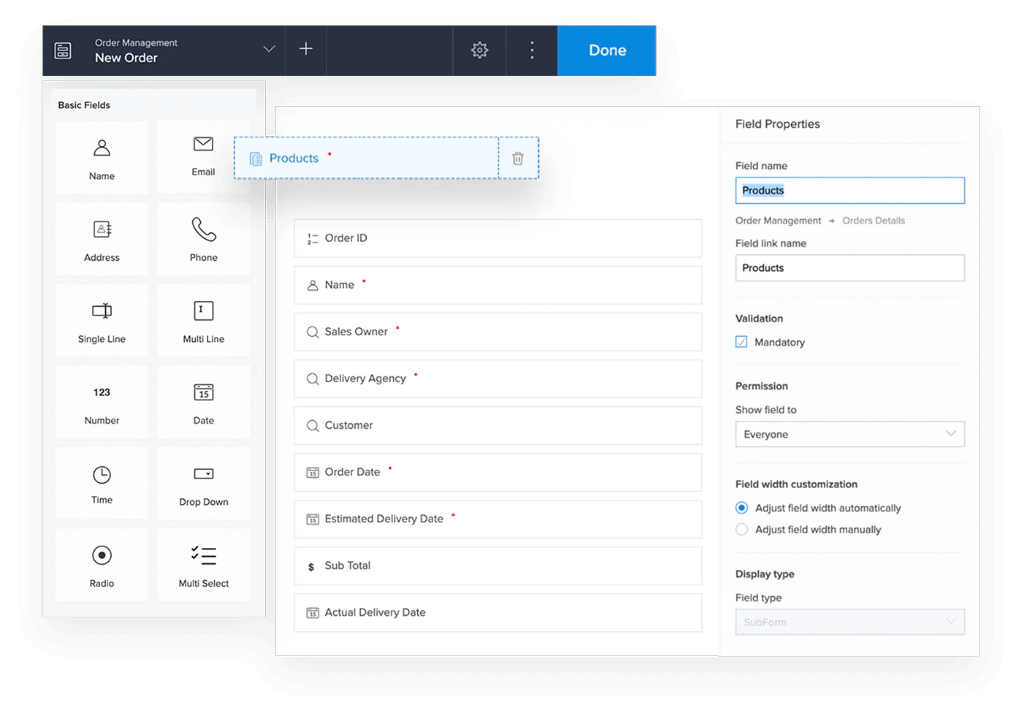Handy Advice To Selecting Low-Code Platform Sites
Handy Advice To Selecting Low-Code Platform Sites
Blog Article
The Benefits Of Low-Code Development For Developing Applications As It Pertains To Integration Capabilities
Low-code integration of applications has many advantages, such as the ability to seamlessly integrate various applications and systems. Here are key benefits from pre-built connectors, APIs, as well as other tools:
Connectors that are wide-ranging Low-code platforms come with an extensive collection of connectors that are pre-built for popular enterprise system (e.g. ERP, CRM databases cloud services, etc.). This makes it easier for integrating with these systems.
API Integration: A lot of Low-Code platforms include out-of box API integration tools that let developers effortlessly connect external services as well as data resources.
Easy To Use
Drag-and-Drop Integration integration tasks can usually be done using drag-and drop interfaces, making it accessible to both developers and non-developers to create complex integrations without writing extensive code.
Visual Workflow Builders Visual tools to create workflows and data flows aid in understanding and establishing integrations more intuitively.
Standardized Integration Methods:
SOAP and RESTful Services: Support for standard web services protocols like REST and SOAP allows for simple integration with a range of other systems and applications.
OData and Other Standards: Support for standards like OData enables easy access and manipulation of data on a variety of platforms and applications.
Real-Time Data Synchronization:
Low-code platforms allow for real-time integrations between systems and applications. This allows information to be consistent and updated in all areas of the company.
Event-Driven Architect: Certain platforms come with structures that are event driven, allowing applications to respond immediately to any event. This is essential for interactive and dynamic applications.
Legacy System Integration:
Low-code platforms offer a variety of tools to connect with existing systems. They let organizations modernize IT without re-designing their current systems.
Data Migration Tools Data Migration Tools aid in the transfer of data from old systems to new software built using low-code platforms.
Third-Party Service Integration:
Cloud Services Integration: The seamless integration of cloud services like AWS Azure, Google Cloud facilitates the easy deployment and scale-up of applications.
Integration of Business Applications: Lowcode platforms can be utilized to connect various business applications, such as Salesforce, SAP, Microsoft Dynamics etc., creating a cohesive workflow between different business functions.
Simplified Data Processing
Unified Data Models: Some platforms that use low-code provide unified data modeling which makes data integration easier and management across multiple platforms.
Data Connectors: Pre-configured data connectors allow easy access to and manipulation of data from diverse sources.
Security and Compliance
Secure Integrations: Low-code platforms guarantee that integrations adhere to security protocols and standard safeguarding data while in transportation as well as during rest.
The platforms come with features that guarantee integrations comply with regulatory requirements (e.g. GDPR, HIPAA), giving companies that handle sensitive information peace of mind.
Extensibility:
Low-code platforms often meet complicated integration requirements by incorporating custom code or scripts. They provide flexibility, without compromising the user-friendliness.
Plug-in Ecosystem : An ecosystem of plugins and extensions that will enhance integration capabilities through allowing users to easily create new features as needed.
Low-code platforms are a powerful instrument to create interconnected robust and scalable applications. These platforms streamline the process of connecting different IT systems, increase the flow of data, and aid businesses adopt existing technologies, while also leveraging new ones. See the recommended I thought about this about Low-code Platform for application development for website info including cross platform mobile dev, develop web application, multiplatform mobile app development, azure sql server, application modernisation, microsoft azure sql, paas service, develop cross platform mobile app, database in azure, mobile app development platforms and more.
Advantages Of Low-Code Application Development In Terms Of Cost-Efficiency
Low-code application development offers numerous advantages when it comes to cost-efficiency and efficiency, which makes it an appealing choice for companies looking to maximize their development budgets while delivering high-quality applications. These are the main benefits:
Lower Coding Requirement: Lower coding platforms eliminate the requirement to code manually and save developers time as well as money. This leads to lower costs of labor.
Reduced Developer Resources: Because low-code is more efficient and less time to create, less skilled developers will be needed. This could drastically cut costs for hiring and staffing.
More Time to Market
Accelerated Development Cycle: Visual tools for low-code platforms and components enable rapid application creation, which allows businesses to launch products faster. This can lead increased revenue and boost the competitive position of their products.
Rapid prototyping. Businesses can rapidly test and build prototypes. This cuts down time during the development phase, and enables faster iterations that are based on feedback from users.
Lower cost of maintenance:
The modular architecture and standardized components of applications built on low-code platforms make them easier to maintain. It reduces the cost of maintenance and support.
Automated Updates: A lot of low-code platforms can handle patches and updates in a way that is automatic and ensure that applications are secure and up-to date without needing lengthy manual intervention.
Efficient Resource Utilization:
Contributions from Non-Developers Low-code platforms allow people who are not developers to participate in the development process. This democratization in development allows employees and employers to work together, thus reducing the dependency on high-paid developers.
Optimized use of IT resources: IT departments have the opportunity to focus on more strategic initiatives, instead of getting bogged down with mundane development tasks. Overall productivity and efficiency are improved.
Pricing models that can be scaled:
Subscription-Based Prices: Many lowcode platforms are flexible and have subscription-based pricing models that grow with usage. This lets businesses match their spending to their needs and grow.
Pay-Asyou-Go Options Certain platforms permit companies to pay for only the services they use. This is particularly useful for startups or small businesses that have limited budgets.
Reduction in Third-Party Software Costs:
Built-in Functionalities : Low-code software usually comes with built-in functionality and integrations which reduces the requirement for additional third-party tools, software and licenses.
Pre-Built Intergrations: The ability to use pre-built integrations and pre-built integrations of popular applications and systems reduces the need for custom development, and helps save time and money.
Improved ROI
Improved ROI: Businesses can gain a greater return on investment for their applications by combining rapid development, reduced costs and speedier time to market.
Enhanced Ability. Businesses are able to adjust quickly to changing market conditions and customer needs. This helps them remain relevant, and they are able to take advantage of new opportunities.
Lower Cost of Training:
User-Friendly Interfaces: Low-code platforms provide intuitive and simple-to-use interfaces, which reduces the learning curve.
Accessible Resources that are accessible. A lot of low-code platforms offer extensive training materials, tutorials, as well community assistance. They reduce the need to undergo formal training, which can be costly.
Collaboration can be streamlined.
Enhanced Collaboration Tools : The collaboration tools that are built into the software help in communication and coordination between the team members. This results in a more efficient project development process and lower overhead.
Unified Development Environment (UDE): An unified, single development environment that streamlines workflows and reduces cost and complexity that comes with managing various tools and platforms.
Overall, the efficiency of software development using low-code can be attributed to its ability to reduce the cost of maintenance and development, increase time to markets and optimize the use of resources and offer flexible pricing models. This combination of factors offers businesses substantial financial benefits and makes low-code an appealing option for businesses looking to make the most of their budgets for development, while still creating strong and flexible applications. View the best look at this for website recommendations including stored sql procedures, microsoft azure sql, build with docker, cross platform mobile dev, software for app development, rapid action development, application development platforms, low code development platforms, stored sql procedures, driver jdbc and more.
The Benefits Of Low-Code Programming For Both Community And Vendor
Low-code application development platforms can be a fantastic option to obtain vendor support as well as community involvement. Both of these aspects are vital for ensuring the success of your implementation as well as ongoing maintenance of the app. Here are the major benefits: Support from the vendor
Comprehensive Technical Support:
Dedicated Support Team: Many low-code platforms come with dedicated support staff that are available to help with technical queries, troubleshooting issues and providing advice. They can ensure that issues are resolved promptly.
Some vendors offer 24/7 support. This is useful for companies that operate in different time zones.
Training and Onboarding
Vendors often provide organized programs for users like tutorials and webinars. They might also offer certification courses.
Customized Onboarding : Many companies offer customized onboarding which assist new customers implement the platform and customize it to meet their individual requirements.
Regular Updates, Enhancements, and Improvements:
Continuous improvement: Low-code platforms typically release regular updates that include new features, performance improvements and security patches ensuring that the platform remains cutting-edge and secure.
Feedback Integration: Vendors frequently integrate feedback from users into their development cycles, making sure that their platform is constantly evolving to meet the changing requirements of their users.
Comprehensive Documentation:
Documentation - Comprehensive Documentation: A complete and well-organized document covering everything from basic use to advanced modifications are often accessible. This allows users to solve issues on their own.
API References: API documentation is detailed and helps developers to integrate the platform with other systems and also to adapt their apps.
Professional and Consulting Services
Expert Consulting: Vendors typically provide consulting services to help in the process of strategic planning, architecture design, and complicated implementations, to ensure that users can leverage the platform to its fullest potential.
Custom Development Services: A few companies offer custom development services to create specific integrations or features that are not available out-of-the-box.
Community Support
Active User Communities
Forums and Discussion Boards: Many low-code platforms have vibrant online communities where users can discuss issues, ask questions, and share solutions, and share best practices.
Meetups and User Groups: Local or virtual user groups and meetings offer opportunities for learning, networking and sharing knowledge.
Knowledge Sharing & Collaboration:
Community-Contributed Resources: Users often share templates, modules, and extensions that they have developed, which can be reused or adapted by others, accelerating development and innovation.
Crowdsourced Solutions: The collective experience, experience and expertise of a community may be an effective tool for troubleshooting and finding creative solutions.
Learning and Development:
Community-led training: Many communities offer workshops, webinars and training sessions that are led by knowledgeable users.
Online Tutorials and Courses The community members create and publish tutorials, online courses and step-by-step guides. This improves the learning resources that are available to users.
Feedback and Influence
Product Feedback Channels: Community forums usually provide feedback to the manufacturer which may influence the creation of new features or improvements.
Beta Testing Programmes: Community members who are active be able to participate in beta testing programs. This allows them to get an early view on new features as well as a chance to help shape the evolution of the platform.
Recognition and Encouragement
A lot of vendors have community recognition programs, such as MVP programs (Most Valuable Professional), to recognize the efforts of their members who are involved in their communities.
Peer Support. Community members provide peer-to-peer support. They share their knowledge with users who are less familiar and offer guidance. This creates a community that is supportive and collaborative.
Overall the combination of strong support from the vendor and an active and engaged community creates an entire support network for low-code application development. The combination of robust vendor support and an active and engaged community creates an extensive support system for low-code development.